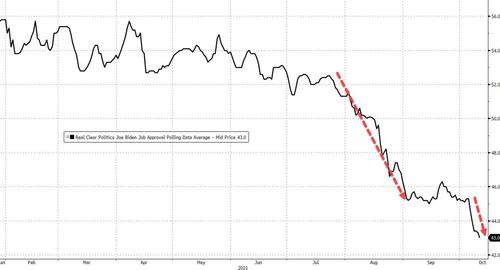Stoddard: If Polls Are Right, Dems Are Doomed; If They’re Wrong, It’s Worse
Authored by A.B.Stoddard via RealClearPolitics.com,
In less than three months, President Biden’s approval rating has tumbled from a remarkable position in a polarized nation to the lowest of all but two presidents since 1945. Democrats are panicked though refusing to course-correct, hoping the pandemic will retreat, the economy will rebound, and their agenda will pass through Congress and turn out to be popular down the line.
The standing of the party with voters, at this time, isn’t in doubt. It’s awful. Biden’s average job approval rating on July 20 was 52.4% in the RealClearPolitics average before tanking precipitously and taking the party’s fortunes with him as the delta variant surged and American troops withdrew from Afghanistan in a deadly and tragic exit. RCP currently has him at 43.3%. His approval in Gallup has dropped 13 points since June, six points in this last month. The latest Quinnipiac University poll had Biden’s approval/disapproval at 38/53, down four points in three weeks. Specific findings on leadership questions were dreadful, with Biden’s numbers falling since April by nine points on the question of whether he cares about average Americans, seven points on whether he is honest, and nine points on whether he has good leadership skills.
The latest Morning Consult/Politico findings from last week showed Biden’s approval underwater across the board, at 45% approval overall, at 40% on the economy, 44% on health care, 40% on national security, 33% on immigration and 36% on foreign policy. The only number not underwater was Biden’s COVID approval of 49%-46%, 30 points lower than it was last spring. Across all polling Biden’s approval on the questions of competence and accomplishment have suffered. And that Morning Consult/Politico survey stated, “The shares of independent and Democratic voters who say Biden has underperformed expectations have doubled over the past three months.”
The decline in COVID deaths, hospitalizations and infections and the disappearance of Afghanistan from the news has done nothing to stabilize the downward trajectory. In order for Democrats to stay competitive in the midterm elections, Biden’s approval would have to get back up to 50%-52%.
Low presidential approval ratings have correlated to significant losses for the president’s party in the last four midterm elections of 2018, 2014, 2010 and 2006.
Meanwhile Republicans have narrowed the margin in the congressional generic ballot, and a September Morning Consult/Politico poll found “58% of GOP voters say they’re ‘extremely’ or ‘very’ enthusiastic to vote in the 2022 midterms, up 10 points since July.”
Even if their polling was good, Democrats face fierce headwinds next year: historical trends that favor the party out of power in the midterms in a president’s first term, a fragile four-seat margin in the House and no margin in the Senate, all of which can easily erase their congressional majorities, and redistricting maps that favor the GOP. In addition, the party is facing new liabilities in voter registration — it has lost registered voters in critical states in considerable numbers. The Hill reported registration is down for Democrats since 2019 in Florida by more than 200,000, in North Carolina by more than 135,000, and in Pennsylvania by more than 200,000. Democrats have seen marginal increases in party registration in Arizona and New Hampshire.
Yet while Democrats are bracing themselves for a wipeout at the ballot box next year, they may not know the true extent of their loss of support among voters. Polling before last year’s election, in which Biden only prevailed by fewer than 43,000 votes in three swing states, was the least accurate in 40 years.
Postmortem assessments are complicated and, largely, inconclusive. But several point to the likelihood that both Republican and Democratic polls — almost all of which favored Biden over President Trump — were off by an average of four percentage points; that most surveys likely oversampled liberal Democrats; that a surge of new voters could have contributed to the polling errors; and that Trump supporters were less likely to respond to pollsters because Trump repeatedly characterized them as “fake” or “suppression polls.” While 2022 will not be a presidential year, a study of 2020 polls by the American Association of Public Opinion Research found that “[t]he overstatement of the Democratic-Republican margin in polls was larger on average in senatorial and gubernatorial races compared to the Presidential contest. Last year Democrats poured record sums into Senate races in red states like Montana, South Carolina, Kentucky, Kansas and Iowa because the polling looked so promising — only to lose them all.
Certainly voter turnout can defy any polling predictions. But Democrats will have a rough time turning out their voters next year when the base of the party is likely to feel more disappointment than gratitude for the party’s accomplishments in 2021 and 2022, and the GOP base is likely to be highly energized.
A few weeks from now the first consequential bellwether election will take place in Virginia where former governor Terry McAuliffe, who is running again, is tied with Republican Glenn Youngkin in the polls. If McAuliffe pulls it out, Democrats will likely dismiss the scenario that polling around the rest of the country is portraying for them next year. They shouldn’t.
Much can happen in a year, Democrats hope for improvement in the economy and the pandemic, and a return on their far-reaching “infrastructure” agenda may materialize. Revelations from the select committee investigating the Jan. 6 insurrection may challenge GOP candidates trying to avoid any daylight between their campaigns and Trump. Trump’s war with the GOP, and his constant messaging to its voters that all elections are rigged, may cost the party substantial voter turnout in key districts or states.
But Democrats shouldn’t count on it. They should believe the polls and campaign like they do.
Tyler Durden
Mon, 10/11/2021 – 21:40
via ZeroHedge News https://ift.tt/3FDN9fV Tyler Durden

